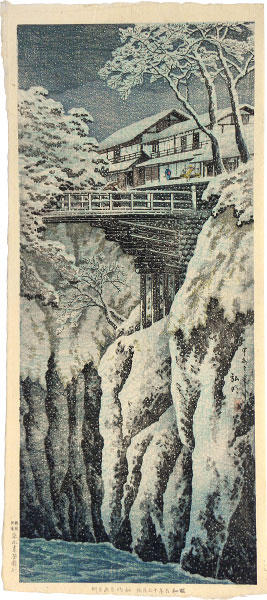| Notes (first edition)?: |
Takahashi Hiroaki (Shotei), 1871-1945
Saruhashi Bridge in Koshu Province
(Koshu Saruhashi)
With title and signature at right, Koshu, Saruhashi, Hiroaki, followed by red artist's seal no in(?), dated along bottom margin, Showa rokunen junigatsu saku Hiroaki jiga jikoku (Showa 6 [1931], 12th month, self-designed and self-carved by Hiroaki), with publisher's seal at lower left margin, Hanyen shoyu Fusui Gabo hakko (copyright owned by Fusui Gabo Company), 1931
otanzaku tate-e 20 3/4 by 9 1/8 in., 52.6 by 23.3 cm
Although Hiroaki declares after his signature 'jiga jikoku' (self-designed, self-carved), perhaps the assertion regarding 'jikoku' is is more indicative of his direct involvement in the production the block set and his approval of the printing as opposed to actually carving all of the blocks himself.
References:
Reigle Stephens, Amy, gen. ed., The new wave: Twentieth-century Japanese prints from the Robert O. Muller Collection, 1993, p. 113, pl. 93
Reigle Newland, Amy, gen. ed., Printed to Perfection: Twentieth-century Japanese Prints from the Robert O. Muller Collection, 2004, p. 44, no. 15
Hisao Shimizu, Syotei (Hiroaki) Takahashi, 2005, p. 66, no. 322
Hisao Shimizu, The Collected Print Works of Shotei Takahashi, A Modern Ukiyo-e Painter, 2006, no. 113 (and inside cover flap) |
|
| Artist Bio: |
Takahashi Shotei was born in Tokyo with the given name of Takahashi Katsutaro. At a young age he was trained in Nihon-ga , the traditional Japanese painting style by his uncle Matsumoto Fuko, and beginning around 1907 Shotei started designing for the Watanabe Color Print Company. Shotei was among the first designers to be recruited into Watanabe's stable of artists, which would later expand to include Goyo, Shinsui, Hasui, Kasamatsu, Koson and Koitsu among others. Many Watanabe prints were designed for export, primarily to North America, where the demand for all things Japanese was high in the early 20th century.
By 1923 Shotei had produced nearly 500 designs for Watanabe, when Tokyo was hit by the Great Kanto earthquake -- the worst recorded natural catastrophe in the history of Japan. The fires ignited by the earthquake raged for three days, and Watanabe's print shop and all the woodblocks created by Shotei and the other early shin hanga artists, were destroyed.
After the earthquake Shotei created another 250 prints mostly depicting scenic Japanese landscapes in the shin hanga style he had helped to define. He continued to work for Watanabe, but also worked with the publishers Fusui Gabo and Shobido Tanaka, where he had more control over the finished print than was possible with Watanabe.
Shotei used a variety of names, signatures and seals during his lifetime. From 1907 until 1922 he used the name Shotei, and after 1922 Hiroaki and Komei.
|
|





